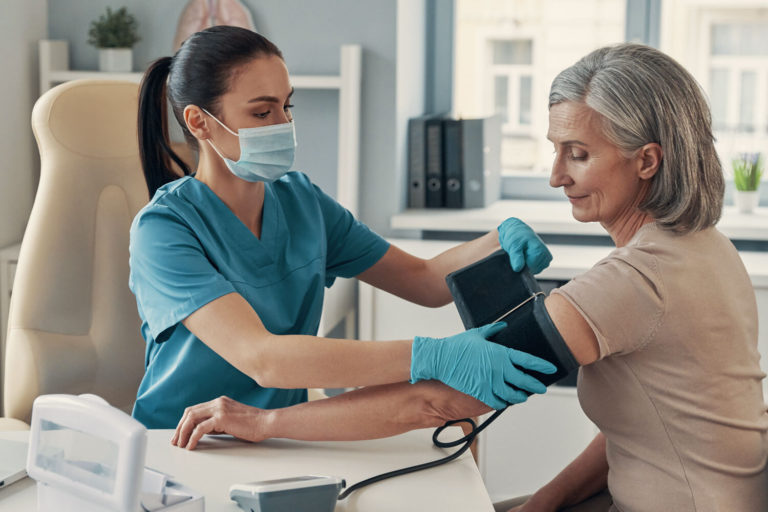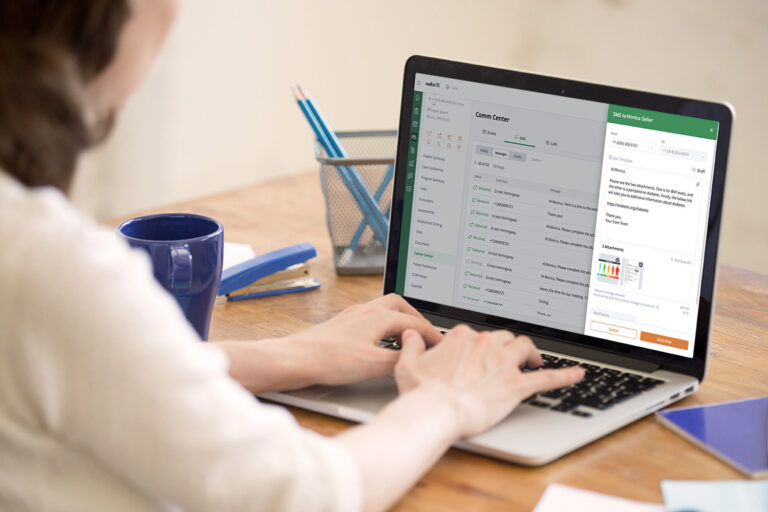How Remote Monitoring in Healthcare Improves Care Management
The term “remote monitoring in healthcare” may conjure images of robotic clinical data exchanges and artificial intelligence takeovers. In reality, remote monitoring in healthcare has provided a convenient experience for most patients who learn to use it. Why? It’s easy, convenient, and customizable.
The more frequently and conveniently patients can reach out from the comfort of their kitchen, bedroom, or even car, the more empowered they’ll feel about their care—and the more they’ll trust their healthcare providers.
What are the benefits of remote monitoring in healthcare?
Telehealth profoundly expands the functionalities of Care Management and nurtures relationships to verifiably enhance the patient experience. Remote monitoring in healthcare stimulates interaction that’s more thorough and efficient, but also more relaxed and intimate.
The Pew Research Center reports that 92% of American adults now have a smartphone—so they’re comfortable with, and even dependent on, this handy communication device. Many prefer sending digital data to their healthcare provider at a convenient time and place rather than making a routine-disrupting excursion to the doctor’s office.
Providers who deliver care at a distance, on the other hand, find that convenient access to patient data may lead to improved health outcomes. This liberates them to care for more patients at a lower cost while also experiencing less burnout. It’s a win-win scenario. Let’s review the most significant benefits of remote monitoring in healthcare.
Improved quality of care
Patient-generated data offers valuable insights that care providers wouldn’t otherwise have access to—that means they have more tools to tap when assessing, diagnosing, and prescribing care.
According to a Leading Age white paper, medical professionals especially value remote monitoring in healthcare when delivering geriatric care. Once they’re able to monitor and access patients’ activities and physiological parameters, it becomes easier to discover patterns and craft higher quality care plans.
Collecting more critical data helps them achieve better health outcomes. They also find that remote monitoring in healthcare allows them to integrate administrative and service tasks with increased efficiency.
Instead of waiting—as many patients do—until their condition has dangerously deteriorated to schedule and manage a visit to their care provider’s office, remote healthcare monitoring enables them to engage in self-observation and symptom analysis with their providers, in real-time.
When they’re able to collect their own data from wearables and other telehealth devices, patients play a more active role in their care and share in decision-making. The more a doctor trusts patients to understand their own condition and treatment, the more patients will trust that doctor’s recommendations—and the more engaged they’ll be in their care. Remote monitoring in healthcare promotes patient engagement, which leads to better health outcomes and patient satisfaction.
Increased care plan compliance
When patients are engaged in generating their own health data, they’re more likely to feel like a true partner rather than just a patient—so they’re more likely to comply with their provider’s instructions and data-sharing expectations.
This consistently-collected data enables care providers to gain valuable insight into what a patient is or isn’t doing. Even when patients do skip a step in their care plan, it’s easier to discover why. Maybe it’s because they haven’t received enough education. Or maybe an unexpected event or another disabling condition disrupted their routine.
Whatever the reason, patients who are already in the habit will communicate it to their clinician, who can then offer resources to help them better understand their care plan or get back on track with their treatment. Remote monitoring in healthcare empowers patients to be accountable and feel they’ve contributed to their recovery.
How can remote monitoring in healthcare support Care Management programs?
Healthcare providers in all specialties are reporting how much more efficient and organized their workflow has become since they’ve started supporting their Care Management strategies with remote patient monitoring.
Decades-worth of global studies have demonstrated that stress exacerbates most chronic and acute conditions. Ideal outcomes are much more difficult to accomplish when both patients and clinicians are stressed and scrambling to translate the plan on paper into real-life healthcare.
Remote monitoring in healthcare allows you to keep track of your patients’ vital signs and chronic conditions whether they’re at home, at work, in transit, or vacationing. When you’re regularly instructing them on how to follow your instructions, they become more comfortable with you and your care—and, more likely to follow it.
Meanwhile, you’re also cutting costs for your practice. You can improve your treatment efficacy for a variety of conditions when your patients enjoy the benefits of remote monitoring in healthcare.
Remote monitoring in healthcare use cases
For a wide range of patient populations, devices that enable remote monitoring in healthcare make chronic disease management less of a stressful scramble and more of a friendly conversation. They also enable various specialists to do their jobs more effectively, efficiently, and enthusiastically. Knowledge is power, and empowering clinicians with data motivates them to focus and follow through on even the most complex, persistent conditions like these:
Diabetes
To manage type 2 diabetes effectively, patients need to have their blood sugar (glucose) levels monitored continuously. Studies published in the National Library of Medicine have demonstrated that remote monitoring in healthcare effectively assists in controlling glucose levels. How?
Extracting a drop of blood then measuring and sending glucose levels to a provider enables patients to monitor the effects of medication, diet, exercise, and stress on their condition. This information empowers them to take control of their health and track their progress.
Hypertension
The American Heart Association projects that over 42% of US adults will be hypertensive by 2035—costing healthcare organizations over $150 billion. Hypertension patients must be extremely vigilant, and remote monitoring in healthcare enables them to be so.
The same American Heart Association research shows that real-time monitoring programs can reduce systolic blood pressure (SBP) and diastolic blood pressure (DBP) significantly, compared to traditional self-monitoring. This can lower the incidence of hypertension-related acute events, cutting costs of hospital stays and ER visits.
COPD
Chronic obstructive pulmonary disease (COPD)—the chronic obstruction of lung airflow that interferes with normal breathing—is not fully reversible and requires close management. Rehospitalization is a substantial burden for COPD patients and their families. That’s why pulmonary rehabilitation is critical for strengthening breathing muscles and avoiding those ER visits.
COPD monitoring systems enable patients to better understand their disease, its symptoms, exacerbations, and control tactics. Studies have found that remote monitoring in healthcare can help enhance traditional rehab services, improving patients’ quality of life and clinical outcomes while reducing medical intervention and hospitalization costs.
Behavioral Health
According to the CDC, 1 in 5 U.S. adults experience mental illness each year, and people with depression have a 40% higher risk of developing cardiovascular disease. Yet, there simply aren’t enough mental health providers across the country to cover this overwhelming caseload.
Remote monitoring in healthcare can help forge the bonds of the kind of deep trust required to overcome potential mental health crises. Preventing traumatic breakdowns becomes easier when RPM (remote patient monitoring) technologies help enable stigma-free, ongoing care to highly-engaged, trusting patients.
Senior Care
More American seniors are choosing to live at home longer. That independence, however, comes with a responsibility to monitor chronic conditions like heart disease, high blood pressure, balance issues, memory loss, and digestive dysfunctions.
Wearables and connected devices enable patients to gather and transmit vital signs, symptoms, and treatment efficacy factors to their caregivers. Tablets and other monitoring devices also enable follow-ups, as well as daily medication and exercise reminders.
Care coordination and management in-between home visits become less of a chore when seniors can communicate via phone, text, or video with trusted providers. Used consistently, devices that enable remote monitoring in healthcare can also help seniors who live alone engage in much-needed interaction with someone who cares and is sincerely willing to listen.
Should your Care Management program integrate technology that enables remote monitoring in healthcare?
The studies have been done. The patients have had their say. If you’re treating patients with chronic disease and not much enthusiasm for frequent doctor visits, and if you want to increase patient engagement, you should consider adopting remote monitoring in healthcare settings where you use your Care Management program. Ultimately, it will boost your bottom line.
The future of healthcare is here—don’t miss out on the benefits your competitors are already enjoying. Download our Definitive Guide to Remote Patient Monitoring and start helping your patients improve their health outcomes.
About the Author:
Michelle Pampin is the CEO of Welkin Health, a Care Management platform focused on improving health outcomes for people living with chronic diseases. Michelle is an accomplished leader, with a track record of advancing high-growth Silicon Valley software companies. Michelle speaks three languages: Spanish, French and Portuguese. When she’s not busy leading Welkin, she is busy staying active with her Samoyed, Avi.


